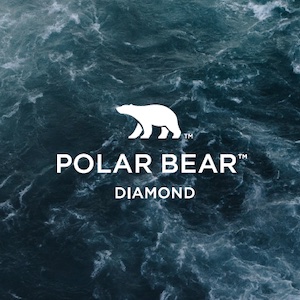
The polar bear insignia, which brands diamonds as being of Canadian origin, is making a comeback, say government officials of the Northwest Territories (NWT).
The logo—which in 2000 scored a publicity coup when it landed on the front page of The New York Times—will be used only for diamonds that are not just mined in one of the NWT’s three producers, but also cut and polished there.
The government has subcontracted the polar bear license to Diamonds de Canada, which has an NWT factory that uses automated technology for cutting.
The insignia, inscribed on the diamond’s girdle, has also gotten a refresh.
“We believed it was still a respected and valued brand,” says Andy Leszczynski, director of diamonds, royalties, and financial analysis for government of the Northwest Territories (GNWT). “But we wanted to give it an identity that better resonated.”
The government enlisted a graphic design firm to bring the bear “into the 21st century,” says German Villegas, manager of diamonds, secondary industry, for the GNWT.
“We wanted to make it a dynamic polar bear,” Villegas explains. “It is more agile and it’s softer. It’s not aggressive; it’s looking upward to the future. We changed that static aggressiveness that we had in the past.”
Diamonds de Canada CEO Benjamin King thinks the new one is more “health conscious.”
“The first one was a little more overweight. This one is more ripped. He’s not a roly-poly polar bear anymore. He has more self-confidence. He’s more purposeful.”
Diamonds de Canada plans to inscribe only 16,000 diamonds with the polar bear mark, which equals the number of polar bears currently in Canada. Part of the proceeds will go to government research efforts.
That 16,000 number is a hard cap, King says, “unless they find an ice floe of 10,000 more polar bears.”
He expects to have them all sold within a decade. But he’s glad that this is a limited-edition product.
“You see so many brands cycle up and they become a shadow of themselves. In 30, 40 years from now, people may be happy to have 1 of 16,000.”
The company will put the insignia only on diamonds of 1.5 carats and above. It will also offer brown and yellow diamonds in the mix.
“We want to show the diversity in production from each one of these locations,” he says. “So we can say, this one comes from [the Ekati mine], this one comes from Diavik, which is shutting down in five years. That is something our industry has really failed to communicate, the finiteness of diamonds, that in five years you’re not going to see Diavik diamonds anymore.”
The diamonds will be tracked, and sold with GIA Diamond Origin Reports.
“The product appeals to a certain client who wants more out of their purchase and wants to understand where their diamonds came from,” he says.
The diamonds won’t be sold at a premium but be “fairly priced,” he adds.
“You look at what’s happening with Russia, they’re dumping diamonds at a lower price in Dubai,” he says. “Because Canada is so above board, it’s really the benchmark.”
Diamonds de Canada is also selling polar bear “raw diamonds,” rough stones that let consumers choose their eventual polished shape. They’ve proven surprisingly popular, King says.
“When you see a rough stone, there is just something transformative about it. It strikes a basic instinct.”
Along with the diamonds, consumers will get a chance to buy items created by the indigenous population of the NWT, including art, beads, and footwear.
The government decided to sublicense the logo to Diamonds de Canada, so it could make sure that any companies that use it “share the same vision,” says Villegas. Almod Diamonds also has a cutting factory in the NWT, but so far it hasn’t signed up for the polar bear mark, or the NWT government’s other brand, the Government Certified Canadian Diamond.
The fully automated Diamonds de Canada factory is being widely watched to see if it can match the efficiency of operations powered by cheap labor.
King says so far it’s delivered.
“All the software companies that built the tools for the industry lack the actual diamonds. Every day we are adding efficiencies on our yields. You can’t do that unless you have actual diamonds to work with.”
The insignia received a surprisingly warm welcome at JCK Las Vegas, King says.
“It’s been in hibernation for so long that, when we brought it back, people were so excited—much more than I anticipated,” he says.
This year, Villegas and Leszczynski both attended their first JCK show year and found it an eye-opener.
“Most diamond miners lose the reason why they’re mining,” Villegas says. “On the floors of the JCK show, you can really feel why they do what they do. The people are so engaged in jewelry. It is a very passionate way of doing business. Not many industries are as passionate as they are.”
Photo courtesy of Diamonds de Canada
Follow JCK on Instagram: @jckmagazineFollow JCK on Twitter: @jckmagazine
Follow JCK on Facebook: @jckmagazine





